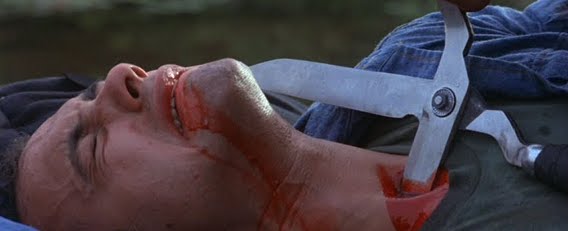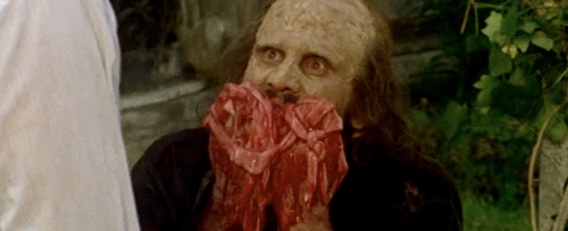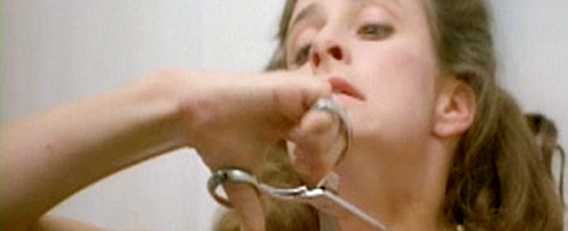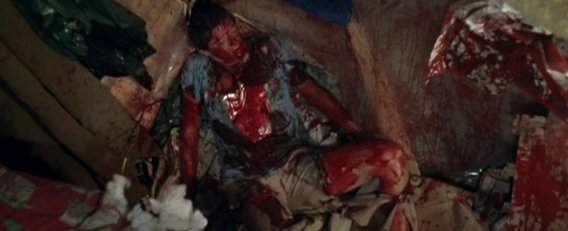
The 1980s was a dark time for artistic freedom, with both music and movies being heavily censored by those that simply did not understand and were out of touch with what younger audiences found entertaining. Whilst musicians in the United States became targets of Tipper Gore and the Parents Music Resource Center (ranging from Judas Priest to Cyndi Lauper), it was horror movies that would fall foul of the censors in the United Kingdom, in what would become known as the ‘video nasties.’ Yet, by the time the moral witch-hunt was at its peak, the debacle had become so outrageous that even the media and parliament would become involved, effectively removing any title that they felt was offensive or corrupt from off the shelves.
The rise of the home video had begun to build momentum towards the end of the 1970s and it would be VHS that would eventually win the race. Most major studios were reluctant to embrace the new format, believing it to be nothing more than a fad and fearful that it would take profits away from cinema distribution. Thus, it would be the smaller companies that dominated the market, purchasing whatever no budget features they could obtain the rights to and releasing them with lewd and outrageous marketing campaigns. More often than not, it would be the titles or posters that would be more explicit than the content of the movies, but as families became exposed to these readily available shockers they were introduced to a new type of film. This would also coincide with a significant leap in prosthetic make-up effects, resulting in an array of gruesome images that terrified their naïve viewers.
Whilst many of the titles to be included on the list of nasties would be of Italian origin, there were also over a dozen slasher movies that would also fall foul of the Director of Public Prosecutions (DPP), who would eventually be responsible for drafting the list that would become the basis of the video nasty case. The first slasher to court controversy would be Nightmare in a Damaged Brain; a low budget splatter from Italian documentary filmmaker Romano Scavolini, whose distributor, World of Video 2000, had taken it upon themselves to promote by running a contest outside a hospital in Surrey… passersby had to guess the weight of a (fake) brain in a jar for the chance to win £50. The publicity stunt would receive a small mention in Video Trade Weekly on May 20th 1982.
It would not be long before the tabloids began to sensationalise the concerns of the country, whilst moral crusader Mary Whitehouse continued the work she had begun in the 1960s with the Clean Up TV Campaign by turning her attention to graphic sex and violence in cinema. The situation soon was out of hand when the authorities showed on two occasions how little research they had done when laying down their laws. The first had seen a list entitled the Children’s Top Ten Nasties, that had compiled a selection of dangerous movies that children had apparently seen on home video. One of these titles, however, was called Zombie Terror, a fictitious movie that many of the children had claimed their parents had rented, proving that the list was a farce. Another ridiculous example took place in Manchester, when police confiscated copies of the Dolly Parton musical The Best Little Whorehouse in Texas, believing it to be pornographic.
The slasher films that would be included on the DPP’s list would be selected for a variety of reasons. For instance, The Burning became a target for a sequence in which a bunch of teenagers are butchered by the movie’s antagonist with a pair of garden shears, whilst Anthropophagous: The Beast would include a scene where the monster removes a foetus from a pregnant woman and sinks his teeth into it in front of her. Other titles, such as Night School and Visiting Hours, would be professionally crafted thrillers that would prove no more offensive than Brian De Palma’s acclaimed 1980 classic Dressed to Kill. But the panic that ensued from the newspaper reports and parliament protests resulted in many of the films being banned and, in some cases, successfully prosecuted (the distributor of Nightmare in a Damaged Brain would be sentenced to eighteen months in jail, although he would only serve six).
The following is a breakdown of each of the slashers to be featured at one time or another on the DPP’s list of ‘video nasties’…

ANTHROPOPHAGUS: THE BEAST
Adopting the moniker Joe D’Amato, Italian filmmaker Aristide Massaccesi gained notoriety during the 1970s for a string of explicit X-rated movies that would often combine elements of pornography and horror. But following such delicious titles as Emanuelle e gli ultimi cannibali (Emanuelle and the Last Cannibals) and Le notti porno nel mondo (Mondo Erotico), D’Amato opted to make a more mainstream movie. Taking what he had learnt from his adult pictures, D’Amato joined forces with his close friend Luigi Montefiori (known to fans as George Eastman, a regular staple of cult Italian schlock) to create Anthropophagous: The Beast. Taking elements from the American slasher genre, as well as the notorious Italian cannibal genre, the film would serve as D’Amato’s introduction to foreign audiences. Having worked with the likes of Mario Bava, Eastman was already well versed in the conventions of the horror film and so began developing the concept alongside D’Amato.
With the assistance of American producer Edward L. Montoro, D’Amato commenced pre-production on Anthropophagous: The Beast, recruiting many of his regular collaborators. The film would be shot by cinematographer Enrico Biribicchi, who at that time was already a D’Amato veteran after working together on several pictures. The special make-up effects were designed by Pietro Tenoglio, another D’Amato regular, who would be responsible for providing the gruesome splatter that would become the movie’s focal point. The film’s most notorious moment, in which Eastman would tear a foetus from the mother and devour it, was achieved by using a skinned rabbit. Filming took place on Cala Feola in the Ponza Islands near Italy, whilst interiors were shot at Rome’s Elios Studios. Released in Italy on August 9th 1980, Anthropophagous: The Beast would be distributed under a variety of titles and would be listed as The Grim Reaper on the DPP’s list of video nasties.
ABSURD
Following the surprise success of Anthropophagous: The Beast, D’Amato was eager to capitalise on his newfound notoriety and so immediately commenced work on a second horror film. Turning once again to Eastman, D’Amato began to discuss potential concepts for their follow-up and, when it became clear that a direct sequel would be ridiculous, decided instead to make an American-style slasher film, using John Carpenter’s Halloween as a basis. With a script entitled Rosso Sangue, translated as Red Blood, the story would see a priest chasing a seemingly indestructible killer, whilst he terrorises a babysitter. Having made such an impression with Anthropophagous: The Beast, Eastman would once again portray the demented monster, although this time he would be more recognisable than the cannibal he had played in the previous movie.
D’Amato would once again surround himself with talent that he had already developed a working relationship with, whilst also acting as his own cinematographer. Rosso Sangue would mark one of Carlo Maria Cordio’s first movie scores, later gaining acclaim for his work on Cannibal Ferox, Lucio Fulci’s Aenigma and Troll 2. The cast would consist of several recognisable faces; Edmund Purdom (who would later direct the 1984 slasher Don’t Open ‘Till Christmas) and Annie Belle, who had appeared in several erotic movies during the 1970s. Principal photography took place in Fiano Romano in Rome in May 1981 and was released in Italy just five months later. As with many European movies of the era, Rosso Sangue would be released under a variety of titles, such as Horrible and Monster Hunter. As Absurd, the film was submitted to the BBFC on August 22nd 1983 and was cut by two and a half minutes, before joining Anthropophagous: The Beast on the list of nasties.
BLOODY MOON
Spanish filmmaker Jesús Franco had spent most of the twenty years following the success of his breakthrough picture Gritos en la noche (The Awful Dr. Orloff) producing an array of adult pictures. In that time, he had also worked with such acclaimed stars as Christopher Lee (The Castle of Fu Manchu) and Klaus Kinski (Marquis de Sade: Justine), whilst both had appeared together in 1970’s Count Dracula. Not one to shy away from new genres, perhaps it was inevitable that Franco would eventually capitalise on the success of the slasher film, with his contribution to the cycle coming with 1981’s Die Säge des Todes, released in the United States as Bloody Moon. The project would see Franco joining forces with German producer Wolf C. Hartwig, who had first entered the film industry with the 1953 documentary Bis fünf nach zwölf: Adolf Hitler und das 3. Reich.
Bloody Moon was a co-production between Spanish and German companies. The cast would mostly consist of German actors, such as Olivia Pascal (who portrayed the title character of Hubert Frank’s erotic 1977 flick Vanessa) and Corinna Drews, whilst Franco would also make an appearance as a doctor. Filming took place in Alicante in Comunidad Valenciana, Spain, in the same region where Franco had shot his 1971 classic Vampyros Lesbos. The gore effects would be created by Juan Ramón Molina, whose other notable credits would include El carnaval de las bestias (Cannibal Killers: Human Beast), released the same year. Bloody Moon was passed by the BBFC on January 26th 1982 and received an X certificate after enforced cuts. The movie would be censored even further when submitted by VIPCO in December 1993.

THE BOOGEYMAN
Having developed a passion for the arts from growing up watching his father, stage comedian Ludwig Manfred Lommel, Ulli Lommel turned to acting in the early 1960s, before gaining international acclaim as a filmmaker with Die Zärtlichkeit der Wölfe (Tenderness of the Wolves). After attended a screening of the movie at the Chicago Film Festival, eccentric artist and producer Andy Warhol requested that Lommel moved to New York and the two collaborated on a series of low budget movies, before Lommel decided that his big break would come with a horror picture. Along with his wife, actress Suzanne Love, Lommel wrote a story that took several key elements from Carpenter’s 1978 classic Halloween and incorporated themes from haunted house movies and recent supernatural hits such as The Amityville Horror, to create The Boogeyman.
With the role of the heroine written specifically for Love, whilst her brother, Nicholas, would portray her on-screen sibling, Lommel turned to cinematographer Jochen Breitenstein, whom he had worked with on the cult classic Cocaine Cowboys. On a budget of $300,000, filming took place around Maryland, with locations including Chesapeake Bay Bridge. Lommel would require several graphic set pieces, most notably a scene in which a semi-naked young woman slits her own throat with a shard of broken glass. The special make-up effects were created by Craig Smith, who had performed similar duties on Charles McCrann’s Bloodeaters (later released on home video as Toxic Zombies). First granted an uncut release by the BBFC on November 7th 1980, The Boogeyman would be included on every draft of the DPP’s list of offensive nasties, before being released in a censored format in 1992.
BOOGEYMAN II
Following the surprise success of The Boogeyman, Lommel collaborated with Love once again on the thriller Olivia, before being approached by a producer with the proposition of developing a sequel to his earlier hit. Lommel had no interest in creating a follow-up to The Boogeyman, but was intrigued by the notion of being given complete creative control over the project and so reluctantly agreed. Intending on Boogeyman II to be perceived as a satire, Lommel cast himself as a director who had no interest in making a movie; a self-referential comment on his own situation. Whilst most sequels merely recycle concepts or plot points from their predecessors, Lommel took it a step further by incorporating a substantial amount of footage from The Boogeyman to take up the second film’s running time.
Lommel would shoot the additional sequences with director Bruce Starr at his home in California over a ten-day period, with a further three days on location. Tim Krog, who had scored the original movie, would return once again to create the soundtrack, whilst special make-up effects artist Craig Smith would also be on hand to assist. Whilst most reviews for The Boogeyman had been negative, opinions on the sequel were even more ruthless, with many dismissing the movie as pointless and without merit (as they would later do with Silent Night, Deadly Night Part 2, which would also recycle footage from its predecessor). Submitted to the BBFC in 1983, Boogeyman II (also referred to as Revenge of the Boogeyman) soon found its way onto the DPP list alongside the first film. Both The Boogeyman and Boogeyman II (the latter as a director’s cut) were finally released in the UK as a double bill in 2004 by low budget label Hollywood DVD Ltd.
THE BURNING
Prior to Miramax becoming a major Hollywood player, founder Harvey Weinstein ran a fledging promotional company for musicians during the 1970s called Harvey & Corky. Eager to turn to film production, he teamed up with his brother and launched Miramax, with the intention of funding a low budget horror movie in an effort to capitalise the recent success of such movies as Halloween. Turning to British filmmaker Tony Maylam, whose music features White Rock and Genesis: A Band in Concert Weinstein had distributed as the double bill Sensasia, they began to fashion a story based on an urban legend set at a summer camp. Whilst the screenplay for what would become The Burning was adapted with Maylam’s former writer, Peter Lawrence, the Weinsteins successfully raised a budget of $1.5m and the services of special make-up effects artist Tom Savini and composer Rick Wakeman, most known for his work with the progressive rock group Yes.
Filming took place in upstate New York, North Tonawanda and Buffalo, with Maylam turning to cinematographer Harvey Harrison, who had shot Genesis: A Band in Concert. The young cast would include several future stars; Jason Alexander (Seinfeld), Fisher Stevens (Short Circuit) and Holly Hunter (The Piano), whilst the film would be edited by Jack Sholder, later known as the director of Alone in the Dark and A Nightmare on Elm Street Part 2: Freddy’s Revenge. Four months after its North American debut, The Burning was submitted to the BBFC and granted an X certificate, although its notorious raft sequence (in which Savini’s trademark gruesome effects would be showcased) would eventually lead to its inclusion on the DPP’s list. Later released in censored form on VHS in 1992, The Burning finally received an uncut release courtesy of VIPCO on August 14th 2002.
DON’T GO IN THE WOODS
Following a string of notorious exploitation movies during the 1970s, independent filmmaker James Bryan was inspired by the newfound interest in the horror genre and decided to produce a movie that could be sold to drive-ins around the country. After suggesting the idea to a writing agent, Peter Turner, he was presented with a screenplay entitled by Sierra by one of his clients, Garth Eliassen. With Bryan having decided to shoot a movie in the wilderness of Utah, he began to tailor the script to suit his needs; removing much of the dialogue, inserting several graphic murder sequences and renaming it Don’t Go in the Woods. Having raised the initial budget through funds he had earned whilst an employee at Sunn Classic, Bryan would eventually reach the necessary $150,000 by joining forces with producers Roberto and Suzette Gomez, whilst also obtaining old film stock at discount prices.
Most of the actors were either cast locally or through contacts, with both Ken Carter and Frank Millen being friends of the director, with the latter having appeared in one of his earlier movies. Theatre actor Tom Drury would be cast as the killer, although Bryan would be forced to assume the role for several scenes due to scheduling conflicts. Filmed on location in the Wasatch Mountains near Salt Lake City, Bryan would choose to shoot without sound, adding the dialogue and sound effects during post-production. The homemade special effects would be handled by Bryan’s wife, Kathie, who would use Kraft BBQ sauce and red dye to create the blood. Despite a poor critical reception, Don’t Go in the Woods performed moderately well in the US but found its way onto the DPP’s list in the UK, although it would later be released uncut as British censorship laws began to relax.

To be continued…

7 Responses to When Slashers Turn Nasty pt.1